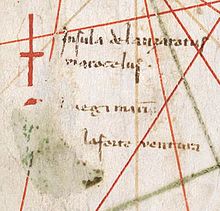Lancelotto Malocello
Lancelotto Malocello ( Latin Lanzarotus Marocelus also Lanzarotto or Lancelotto or Lancellotto or Lazzarotto) was an explorer from the Republic of Genoa . He was probably born in Genoa before 1307 and died before 1384. The place of death is not known. It is believed that he set up a trading post on the Canary Island of Lanzarote at the beginning of the 14th century .
Secured information
There is little reliable information about Lancelotto Malocello from which his life can be reconstructed.
The existence of a Lancelotto Malocello is evident from documents in the archives of the city of Genoa. These are two documents from the years 1384 and 1391. They show that Lancelotto Malocello was married to Eliana Fieschi, who came from a noble Genoese family. These documents also indicate that he had died in 1384.
In the portolan of the Mallorcan cartographer Angelino Dulcert from 1325, the Canary Islands are not specified. In the new edition of 1339 they are drawn on the map and on the island in the immediate vicinity of Africa it is noted that this is the island of the Genoese Lancelotto Malocello. On the corresponding map, the island is marked with a red cross on a white background, the flag of Genoa. However, the flag cannot be interpreted to mean that this area was under the sovereignty of the Republic of Genoa. The expedition of the Genoese Lancellotto was a private company and did not take place on behalf of Genoa. According to the entry on the map, it can be assumed that the islands were occupied before 1339. In the report of the Genoese Niccoloso da Recco, who took part in a voyage of discovery to the Canary Islands in 1341 on behalf of the Portuguese King Alfonso IV, the name Lancelotto Malocello does not appear. Nor does he report a trading post on any of the islands.
Historical environment
Seafaring on the Atlantic was still insignificant in the 14th century and was largely limited to coastal shipping, which connected the Mediterranean with Northern Europe. The use of the compass and other nautical devices allowed for more reliable navigation in the 14th century. Economic historians today assume that the goal of research trips to the Canary Islands was not primarily trade with these islands. The islands offered traders only orcein , goatskins, and slaves. Rather, the islands were viewed as a starting point for the development of the African coast and the hinterland. The fortifications, which the Genoese Lancelotto Malocello probably had built on Lanzarote in the first third of the 14th century, shows that the merchants of this republic intended to establish permanent bases on the archipelago in order to be able to penetrate better into Africa from there.
Individual evidence
- ↑ Alessandro Pellegrini: Lazzarotto Malocello la fama de un mapa naútico . In: XIV Coloquio de historia Canario-Americana . Cabildo Insular de Gran Canaria, Las Palmas de Gran Canaria 2000, ISBN 84-8103-324-3 , p. 789 (Spanish, ulpgc.es [accessed June 28, 2016]).
- ↑ Elías Serra Rafols: Los portugueses de Canarias . Imprenta y Librería Curbelo, La Laguna 1941, p. 12 (Spanish, ulpgc.es [accessed June 28, 2016]).
- ↑ José Juan Suárez Acosta et al .: Conquista y colonización (= Historia popular de Canarias . No. 2 ). Centro de la Cultura Popular Canaria, La Laguna 1988, ISBN 84-404-1254-1 , p. 11 (Spanish, ulpgc.es [accessed June 28, 2016]).
- ^ Antonio M. Macías Hernández: La economía moderna (Siglos XV-XVIII) . In: Antonio de Béthencourt Massieu (ed.): Historia de Canarias . Cabildo Insular de Gran Canaria, Las Palmas de Gran Canaria 1995, ISBN 84-8103-056-2 , p. 140 (Spanish).
literature
- Alessandro Pellegrini: Lazzarotto Malocello la fama de un mapa naútico . In: XIV Coloquio de historia Canario-Americana . Cabildo Insular de Gran Canaria, Las Palmas de Gran Canaria 2000, ISBN 84-8103-324-3 , p. 786-799 (Spanish, ulpgc.es [accessed June 28, 2016]).
- José Juan Suárez Acosta et al .: Conquista y colonización (= Historia popular de Canarias . No. 2 ). Centro de la Cultura Popular Canaria, La Laguna 1988, ISBN 84-404-1254-1 (Spanish, ulpgc.es [accessed June 28, 2016]).
| personal data | |
|---|---|
| SURNAME | Malocello, Lancelotto |
| BRIEF DESCRIPTION | Explorer |
| DATE OF BIRTH | before 1312 |
| PLACE OF BIRTH | Genoa |
| DATE OF DEATH | before 1384 |

